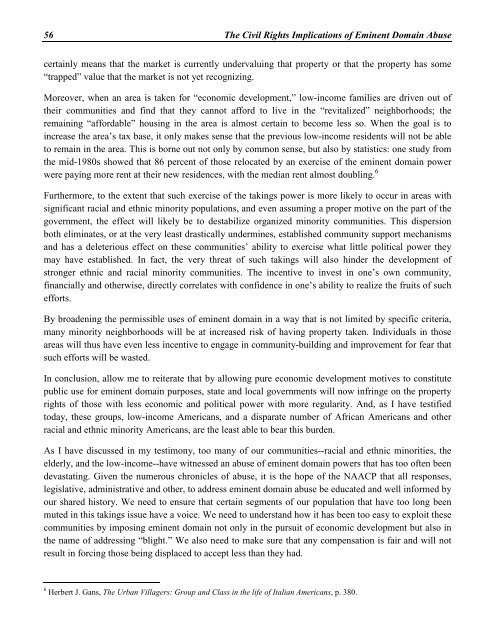Create successful ePaper yourself
Turn your PDF publications into a flip-book with our unique Google optimized e-Paper software.
56 The Civil Rights Implications of <strong>Eminent</strong> <strong>Domain</strong> Abusecertainly means that the market is currently undervaluing that property or that the property has some“trapped” value that the market is not yet recognizing.Moreover, when an area is taken for “economic development,” low-income families are driven out oftheir communities and find that they cannot afford to live in the “revitalized” neighborhoods; theremaining “affordable” housing in the area is almost certain to become less so. When the goal is toincrease the area’s tax base, it only makes sense that the previous low-income residents will not be ableto remain in the area. This is borne out not only by common sense, but also by statistics: one study fromthe mid-1980s showed that 86 percent of those relocated by an exercise of the eminent domain powerwere paying more rent at their new residences, with the median rent almost doubling. 6Furthermore, to the extent that such exercise of the takings power is more likely to occur in areas withsignificant racial and ethnic minority populations, and even assuming a proper motive on the part of thegovernment, the effect will likely be to destabilize organized minority communities. This dispersionboth eliminates, or at the very least drastically undermines, established community support mechanismsand has a deleterious effect on these communities’ ability to exercise what little political power theymay have established. In fact, the very threat of such takings will also hinder the development ofstronger ethnic and racial minority communities. The incentive to invest in one’s own community,financially and otherwise, directly correlates with confidence in one’s ability to realize the fruits of suchefforts.By broadening the permissible uses of eminent domain in a way that is not limited by specific criteria,many minority neighborhoods will be at increased risk of having property taken. Individuals in thoseareas will thus have even less incentive to engage in community-building and improvement for fear thatsuch efforts will be wasted.In conclusion, allow me to reiterate that by allowing pure economic development motives to constitutepublic use for eminent domain purposes, state and local governments will now infringe on the propertyrights of those with less economic and political power with more regularity. And, as I have testifiedtoday, these groups, low-income Americans, and a disparate number of African Americans and otherracial and ethnic minority Americans, are the least able to bear this burden.As I have discussed in my testimony, too many of our communities--racial and ethnic minorities, theelderly, and the low-income--have witnessed an abuse of eminent domain powers that has too often beendevastating. Given the numerous chronicles of abuse, it is the hope of the NAACP that all responses,legislative, administrative and other, to address eminent domain abuse be educated and well informed byour shared history. We need to ensure that certain segments of our population that have too long beenmuted in this takings issue have a voice. We need to understand how it has been too easy to exploit thesecommunities by imposing eminent domain not only in the pursuit of economic development but also inthe name of addressing “blight.” We also need to make sure that any compensation is fair and will notresult in forcing those being displaced to accept less than they had.6 Herbert J. Gans, The Urban Villagers: Group and Class in the life of Italian Americans, p. 380.


